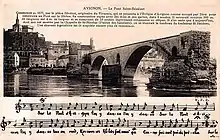Sur le Pont d'Avignon
"Sur le Pont d'Avignon" (pronounced [syʁ lə pɔ̃ daviɲɔ̃]) ("On the Bridge of Avignon") is a French song about a dance performed on the Pont d'Avignon (officially Pont Saint-Bénézet) that dates back to the 15th century. The dance actually took place under the bridge and not on the bridge (sous le Pont d'Avignon, not sur).[1][2][3]

Dance description
- It starts out with everyone in pairs and they dance around each other.
- When the chorus is done stop in front of your partner and traditionally the male will bow on the first part then tip his hat on the second.
- When the chorus begins again repeat step one.
- When this stops so does the dance and then the girl curtsies to one side then the other side.
- For the first part, repeat step one and then if you have an audience turn on your heel and bow to them.
Lyrics
Chorus

Sur le Pont d'Avignon
L'on y danse, l'on y danse
Sur le Pont d'Avignon
L'on y danse tous en rond.
On the bridge in Avignon
They are dancing there, They are dancing there
On the bridge in Avignon
They all dance in circles there
First verse
Les beaux messieurs font comme ça
Et puis encore comme ça.
The fine gentlemen go like this (bow)
And then again like this.
Second verse
Les belles dames font comme ça
Et puis encore comme ça.
The beautiful ladies go like this (curtsy)
And then again like that.
Third verse
Les filles font comme ça
Et puis encore comme ça.
The young girls go like this (salute)
And then like that.
Fourth verse
Les musiciens font comme ça
Et puis encore comme ça.
The musicians go like this (they all bow to women)
And then like that.
Variation
American music publisher Cherry Lane Music Company has printed a different verse (1993):
Les jeunes filles font comme ça
Les jeunes gens font comme ça
The young girls go like this,
The young people go like this.
In popular culture
In 1951, the National Film Board of Canada produced the 5-minute animated film Sur le Pont d'Avignon, in which extravagantly dressed marionettes pantomime the song.[4]
The French fantasy comic book Hypocrite: comment decoder l'etircopyh by Jean-Claude Forest (pub. Dargaud 1973) centres around the destruction of the Pont de Avignon, here imagined as a giant petrified sabre-toothed tiger spanning the river. During the scenes set on the bridge itself, the characters sing this song, led by the ghostly Scottish piper Major Grumble.
In the 1978 American miniseries Holocaust, some of the children in the Warsaw Ghetto sing the song in class with Berta Weiss.
In 1990, The Simpsons' episode The Crepes of Wrath (season 1), Bart Simpson sings the song on the way to his accommodation during his student exchange program.
The Star Trek: The Next Generation episode "Chain of Command" (1992) uses this song as a means for Captain Picard, an appreciator of philosophy and poetry born in France, to resist the effects of torture.
In 1992, a cartoon titledThe Real Story of..... Sur le Pont d'Avignon was produced by CINAR and France Animation, featuring the song and a ghost story revolving around a clockmaker and an enchanted organ.[5][6]
In the German-dubbed version of The Lion King (1994), Zazu sings the song to Scar after being forced by latter to sing something more cheerful than "Nobody Knows the Trouble I've Seen", and instead of singing "I've Got a Lovely Bunch of Coconuts".
The song was played throughout the episode of Bluey called Library.
References
- "Historical articles and illustrations » Blog Archive Sous le Pont d'Avignon – Historical articles and illustrations". www.lookandlearn.com. 25 May 2011. Retrieved 23 December 2018.
- "Sur, or is it Sous, le Pont d'Avignon". 13 April 2015. Retrieved 23 December 2018.
- "Rvcampingeurope.com". www.rvcampingeurope.com.
- "Sur le Pont d'Avignon". nfb.ca. National Film Board of Canada. Retrieved 24 April 2023.
- Prawdziwy Koniec Balu Na Moście w Avignonie / The Real Story of Sur le Pont d'Avignon: part 1. YouTube. Archived from the original on 2021-12-11.
- "SHOWS FOR YOUNGSTERS AND THEIR PARENTS TOO : A behind-the-scenes look at favorite fairy tales and fables on HBO". Los Angeles Times. 9 January 1994.
External links
 Media related to Sur le pont d'Avignon at Wikimedia Commons
Media related to Sur le pont d'Avignon at Wikimedia Commons